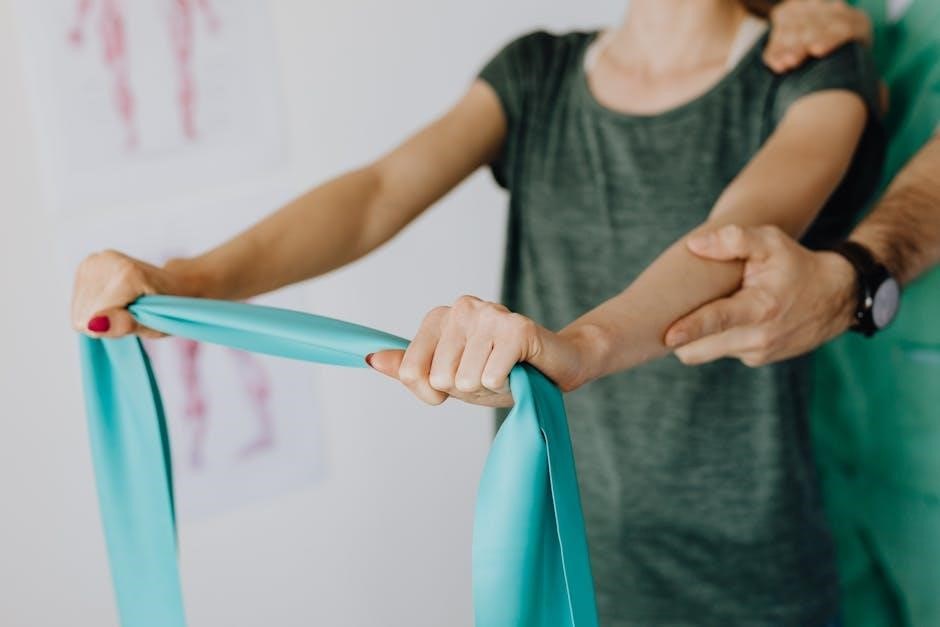The shoulder dislocation rehab protocol pdf provides a comprehensive guide for clinicians and patients, outlining the steps for a successful recovery, using a structured approach with exercises and activities, within a rehabilitation program framework naturally.
Understanding the Importance of Rehab
Rehabilitation plays a crucial role in the recovery process of shoulder dislocation, as it helps to restore function, strength, and mobility to the affected joint. A well-structured rehab program can significantly reduce the risk of future dislocations and improve overall quality of life. The importance of rehab lies in its ability to address the underlying causes of the dislocation, such as muscle imbalances, poor posture, and inadequate core strength. By identifying and addressing these factors, rehab can help to prevent recurrent dislocations and promote long-term stability. Furthermore, rehab can also help to improve range of motion, reduce pain and inflammation, and enhance overall functional ability. A comprehensive rehab program should be tailored to the individual’s specific needs and goals, taking into account the severity of the dislocation, overall health, and lifestyle. With a commitment to rehab, individuals can expect to make a full recovery and return to their normal activities. Effective rehab is essential for optimal outcomes.

Anterior Shoulder Dislocation Conservative Rehabilitation Program
Conservative rehabilitation programs focus on non-surgical methods, utilizing exercises and physical therapy to promote healing and recovery naturally and effectively always.
Factors Affecting Rehab Length
The length of rehabilitation for shoulder dislocation can vary significantly depending on several factors, including the degree of shoulder instability or laxity, whether the condition is acute or chronic, and the length of time the shoulder is immobilized.
The protocol for rehabilitation is tailored to the individual’s specific needs and circumstances, taking into account the severity of the dislocation and the patient’s overall health and well-being.
Other factors that can influence the length of rehabilitation include the patient’s age, activity level, and presence of any underlying medical conditions.
The rehabilitation program is designed to be flexible and adaptable, allowing for adjustments to be made as needed to ensure the best possible outcome for the patient.
By considering these factors, clinicians can develop an effective rehabilitation plan that addresses the unique needs of each patient and helps them achieve a successful recovery.
The goal of rehabilitation is to restore full function and mobility to the shoulder, and to prevent future dislocations or injuries.
A comprehensive rehabilitation program can help patients achieve this goal and return to their normal activities and lifestyle.
The rehabilitation process requires patience, dedication, and a commitment to following the recommended treatment plan.
With the right approach and support, patients can overcome the challenges of shoulder dislocation and achieve a full recovery.
Protocol Guidelines for Clinicians and Patients
Clinicians and patients follow guidelines for rehabilitation, using a protocol to ensure proper treatment and recovery, with exercises and activities, within a structured framework naturally every day.
Progression Criteria and Pace
The progression criteria and pace of the rehabilitation program are crucial for a successful recovery. The program is designed to be flexible, allowing patients to progress at their own pace, with the progression criteria dictating how quickly they can move through the protocol. The pace of the program is not timeline-based, but rather based on the patient’s individual progress and comfort level. Patients are advised to use pain as a guide, only progressing to the next stage of the program when they are pain-free. This approach ensures that patients do not push themselves too hard, which can lead to further injury or complications. By allowing patients to progress at their own pace, the program can be tailored to meet the individual needs of each patient, ensuring a safe and effective recovery. The progression criteria and pace are essential components of the rehabilitation program, working together to help patients achieve a full recovery.

Nonoperative Shoulder Dislocation Protocol
Surgeons recommend nonoperative treatment, using a rehabilitation program to improve shoulder function, for a speedier recovery naturally and effectively every time with great success always.
Rehab Guidelines and Recommendations
The rehab guidelines and recommendations for shoulder dislocation rehab protocol pdf emphasize the importance of a structured approach to rehabilitation, with a focus on improving shoulder function and reducing pain.
The guidelines recommend a gradual progression of exercises, starting with gentle movements and progressing to more strenuous activities, with the goal of achieving full range of motion and strength.
The recommendations also stress the importance of patient education, with patients being informed about their condition, treatment options, and rehabilitation protocol, to ensure they are actively involved in their recovery.
Additionally, the guidelines recommend regular follow-up appointments with a healthcare professional to monitor progress, address any concerns, and make adjustments to the rehabilitation protocol as needed, to ensure optimal outcomes and prevent complications.
Overall, the rehab guidelines and recommendations for shoulder dislocation rehab protocol pdf provide a comprehensive framework for healthcare professionals to follow, to ensure patients receive effective and evidence-based care, and achieve a successful recovery.
The guidelines are based on current research and clinical practice, and are designed to be flexible and adaptable to individual patient needs, to ensure the best possible outcomes.

Overview of the Program Stages
The program consists of multiple stages with exercises, progressing at own pace naturally.
Stage 1 Exercises and Activities
Stage 1 of the shoulder dislocation rehab protocol pdf involves a series of exercises and activities designed to improve shoulder function and strength. The exercises include supraspinatus, shoulder flexion, and shoulder abduction, all of which should be performed in a pain-free manner. Additionally, shoulder extension in prone, shoulder rows in prone, and serratus punch in supine are also part of the stage 1 protocol. These exercises are intended to be progressed at the individual’s own pace, with the goal of improving range of motion and reducing pain. The use of a push-up plus program is also recommended to help strengthen the shoulder muscles. Furthermore, forearm and elbow strengthening exercises are included to promote overall upper limb function. By following the stage 1 exercises and activities, individuals can expect to see improvements in their shoulder function and be well on their way to a successful recovery from shoulder dislocation. The exercises should be performed regularly, with a focus on proper technique and progression.

and Final Considerations
The shoulder dislocation rehab protocol pdf provides a comprehensive guide for individuals recovering from shoulder dislocation, with a focus on improving shoulder function and reducing pain. By following the protocol, individuals can expect to see significant improvements in their overall shoulder health. It is essential to note that every individual’s recovery process is unique, and the protocol should be tailored to meet the specific needs of each person. The use of a structured approach, with a focus on progression and proper technique, is crucial for a successful recovery. Additionally, it is vital to work with a qualified healthcare professional to ensure that the protocol is being followed correctly. With the right approach and guidance, individuals can recover from shoulder dislocation and return to their normal activities. The shoulder dislocation rehab protocol pdf is an invaluable resource for anyone looking to recover from this type of injury, providing a clear and comprehensive guide for a successful recovery, with a focus on long-term results and overall well-being, and proper rehabilitation techniques.



Leave a Reply
You must be logged in to post a comment.